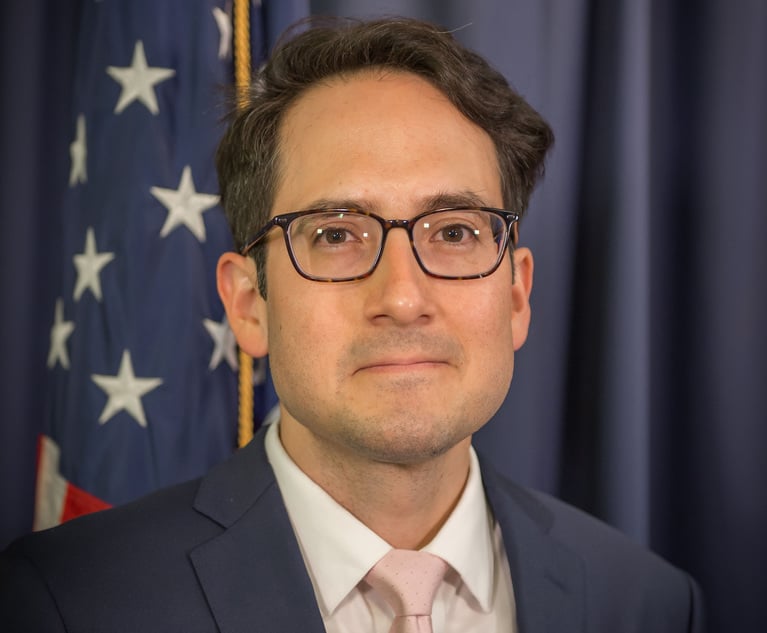Compliance: Supreme Court consideration of greenhouse gas decision a mixed bag
At stake right now is the EPAs current requirement that stationary sources emitting large amounts of GHGs obtain pre-construction permits to install BACT controls when modifying existing sources.
November 13, 2013 at 03:00 AM
5 minute read
The original version of this story was published on Law.com
In late October, the Supreme Court agreed to hear arguments on the D.C. Circuit Court of Appeals' rejection of challenges to the Environmental Protection Agency's (EPA) current greenhouse gas (GHG) regulations in Coalition for Responsible Regulation v. EPA. While there was hope within industry circles that the Supreme Court would use the opportunity to limit the EPA's authority to regulate greenhouse gases, the Court narrowed its review solely to the question of whether the Clean Air Act (CAA) required the EPA to regulate GHG emissions from stationary sources (i.e., power plants and factories), as a result of its regulation of GHGs from mobile sources (i.e., cars and trucks). If the Court rules against the EPA, it will delay but not preclude the regulation of stationary sources. As a result of this decision, counsel should not expect a wholesale evisceration of the EPA's authority to regulate GHG emissions.
A glance into the Clean Air Act
Further explanation requires a quick dive into the murky waters of the CAA. The CAA establishes entirely separate regulatory regimes for stationary sources and mobile sources. The CAA grandfathered numerous stationary sources from having to install new controls until they either modified their existing plants or built new ones. In doing so, however, the sources were required to obtain pre-construction permits and install the best available control technology (BACT). The agency traditionally took the position that if the EPA adopted emissions limits for new pollutants, companies seeking pre-construction permits after that adoption would automatically have to install BACT to meet these new regulations.
The EPA's regulation of GHGs began with mobile sources. When the Supreme Court determined that the CAA authorized the EPA to regulate GHG emissions in Massachusetts v. EPA, it was ruling on the agency's denial of a petition to regulate mobile sources of GHG emissions. The EPA found that GHG emissions from mobile sources endangered human health and the environment (known as the Endangerment Finding), and it adopted what became known as the “Tailpipe Rule” in 2010, to limit those emissions. Although these efforts were directed at mobile sources, EPA was still regulating a new air pollutant. Under the agency's traditional position, this meant that stationary sources seeking pre-construction permits for new or modified sources had to install BACT for GHGs.
This BACT requirement created a whole host of additional problems for stationary sources. The requirement applies only to “major sources,” which the CAA defines as sources emitting more than 100 tons per year of the regulated pollutant. Sources emit GHGs any time they combust fuel, and a sizable office building could easily emit 100 tons per year. Therefore, this requirement would compel thousands of sources to obtain permits, which would wildly exceed the EPA's and states' capacities. To address this issue, the EPA adopted the “Tailoring Rule,” which limited the requirement to obtain preconstruction permits and install BACT only to sources emitting more than 100,000 tons of GHG per year. This primarily includes power plants, landfills and other very large combustion sources.
Appellate court ruling
The challenges to all of the EPA's GHG actions, including the Endangerment Finding, the Tailpipe Rule and the Tailoring Rule, were consolidated into Coalition for Responsible Regulation. Despite the complexity of the issues, in 2012, the Appellate Court ruled unequivocally for the EPA on all points, rejecting both technical challenges to its scientific findings and legal challenges to its authority to regulate GHGs. While the Court grounded the bulk of its reasoning in the Supreme Court's Massachusetts decision, the Court upheld the EPA's determination that the Tailpipe Rule automatically imposed GHG requirements on stationary sources when they obtained pre-construction permits based on EPA policy history.
Despite strong initial reaction from advocates on both sides, the Supreme Court will not be in a position to find that the EPA does not have authority to regulate GHG emissions from stationary sources, because that issue is not before the Court. Similarly, the Court showed no interest in revisiting the EPA's authority to regulate GHG emissions from mobile sources, because its political makeup has not changed since Massachusetts, and the Appellate Court relied heavily on that decision in approving the EPA's actions with regard to mobile sources.
At stake right now is the EPA's current requirement that stationary sources emitting large amounts of GHGs obtain pre-construction permits to install BACT controls when modifying existing sources. This is no small matter. Based on the EPA's current pronouncements, direct regulation of such sources is currently years away and the EPA's current proposals require controls only for newly built sources. Therefore, the only mechanism to require GHG controls on existing stationary sources (many of which are the largest sources of GHG emissions) is the pre-construction permit process.
It appears that the Supreme Court will not make a decision in this case until June 2014, at the earliest. In the meantime, the EPA will continue to impose BACT requirements for existing sources through the pre-construction permit process. Since the EPA's current conception of GHG BACT involves significantly increased efficiency, fuel switching or sequestering GHG emissions in underground caverns, sources producing large amounts of GHG emissions will continue to face significant costs and uncertainties when planning future modifications or new construction.
This content has been archived. It is available through our partners, LexisNexis® and Bloomberg Law.
To view this content, please continue to their sites.
Not a Lexis Subscriber?
Subscribe Now
Not a Bloomberg Law Subscriber?
Subscribe Now
NOT FOR REPRINT
© 2025 ALM Global, LLC, All Rights Reserved. Request academic re-use from www.copyright.com. All other uses, submit a request to [email protected]. For more information visit Asset & Logo Licensing.
You Might Like
View All
State AG Hammers Homebuilder That Put $2,000-Per-Day Non-Disparagement Penalty in Buyer Contracts
3 minute read
Fired NLRB Member Seeks Reinstatement, Challenges President's Removal Power

GOP-Led SEC Tightens Control Over Enforcement Investigations, Lawyers Say

GOP Now Holds FTC Gavel, but Dems Signal They'll Be a Rowdy Minority
6 minute readTrending Stories
- 1States Accuse Trump of Thwarting Court's Funding Restoration Order
- 2Microsoft Becomes Latest Tech Company to Face Claims of Stealing Marketing Commissions From Influencers
- 3Coral Gables Attorney Busted for Stalking Lawyer
- 4Trump's DOJ Delays Releasing Jan. 6 FBI Agents List Under Consent Order
- 5Securities Report Says That 2024 Settlements Passed a Total of $5.2B
Who Got The Work
J. Brugh Lower of Gibbons has entered an appearance for industrial equipment supplier Devco Corporation in a pending trademark infringement lawsuit. The suit, accusing the defendant of selling knock-off Graco products, was filed Dec. 18 in New Jersey District Court by Rivkin Radler on behalf of Graco Inc. and Graco Minnesota. The case, assigned to U.S. District Judge Zahid N. Quraishi, is 3:24-cv-11294, Graco Inc. et al v. Devco Corporation.
Who Got The Work
Rebecca Maller-Stein and Kent A. Yalowitz of Arnold & Porter Kaye Scholer have entered their appearances for Hanaco Venture Capital and its executives, Lior Prosor and David Frankel, in a pending securities lawsuit. The action, filed on Dec. 24 in New York Southern District Court by Zell, Aron & Co. on behalf of Goldeneye Advisors, accuses the defendants of negligently and fraudulently managing the plaintiff's $1 million investment. The case, assigned to U.S. District Judge Vernon S. Broderick, is 1:24-cv-09918, Goldeneye Advisors, LLC v. Hanaco Venture Capital, Ltd. et al.
Who Got The Work
Attorneys from A&O Shearman has stepped in as defense counsel for Toronto-Dominion Bank and other defendants in a pending securities class action. The suit, filed Dec. 11 in New York Southern District Court by Bleichmar Fonti & Auld, accuses the defendants of concealing the bank's 'pervasive' deficiencies in regards to its compliance with the Bank Secrecy Act and the quality of its anti-money laundering controls. The case, assigned to U.S. District Judge Arun Subramanian, is 1:24-cv-09445, Gonzalez v. The Toronto-Dominion Bank et al.
Who Got The Work
Crown Castle International, a Pennsylvania company providing shared communications infrastructure, has turned to Luke D. Wolf of Gordon Rees Scully Mansukhani to fend off a pending breach-of-contract lawsuit. The court action, filed Nov. 25 in Michigan Eastern District Court by Hooper Hathaway PC on behalf of The Town Residences LLC, accuses Crown Castle of failing to transfer approximately $30,000 in utility payments from T-Mobile in breach of a roof-top lease and assignment agreement. The case, assigned to U.S. District Judge Susan K. Declercq, is 2:24-cv-13131, The Town Residences LLC v. T-Mobile US, Inc. et al.
Who Got The Work
Wilfred P. Coronato and Daniel M. Schwartz of McCarter & English have stepped in as defense counsel to Electrolux Home Products Inc. in a pending product liability lawsuit. The court action, filed Nov. 26 in New York Eastern District Court by Poulos Lopiccolo PC and Nagel Rice LLP on behalf of David Stern, alleges that the defendant's refrigerators’ drawers and shelving repeatedly break and fall apart within months after purchase. The case, assigned to U.S. District Judge Joan M. Azrack, is 2:24-cv-08204, Stern v. Electrolux Home Products, Inc.
Featured Firms
Law Offices of Gary Martin Hays & Associates, P.C.
(470) 294-1674
Law Offices of Mark E. Salomone
(857) 444-6468
Smith & Hassler
(713) 739-1250






